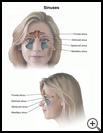
Sinus Congestion
What is sinus congestion?
The nose has seven bony air-filled chambers (sinuses) that help to warm and humidify the air passing through it. When your child has sinus congestion, he or she will have a sensation of fullness, pressure, or pain on the face in an area overlying a sinus. Most children can't accurately report sinus symptoms before 5 years old.
With sinus congestion:
- The pain can be above the eyebrow, between the eyes, or over the cheek bone.
- The pain is usually on just one side of the face.
- The nose is runny or blocked.
- Your child has a sensation of continuous postnasal drip.
It is helpful if a healthcare provider has diagnosed your child with sinus congestion one or more times in the past. This condition tends to be recurrent.
What is the cause?
Sinus congestion occurs when the sinus openings are blocked and normal sinus secretions build up and cause a sensation of pressure and fullness. Sinus congestion occurs mainly with colds and nasal allergies.
How long does it last?
Sinus congestion usually goes away on its own. Without treatment, the sinuses usually open after about a week. The main complication occurs when bacteria multiply within the blocked sinus, causing a sinus infection (sinusitis). This leads to fever and increased pain. Sometimes the overlying skin (around the eyelids or cheeks) becomes red or swollen. This type of sinusitis needs antibiotics and happens in about 5% of colds.
Frequent throat-clearing of postnasal secretions usually leads to a sore throat.
How can I take care of my child?
- Nasal saline
Use saline (salt water) nose drops or spray followed by suction or nose blowing to wash dried mucus or pus out of the nose. These products are available in drug stores without a prescription. If you don't have saline, teens can use a few drops of clean tap water.
Use nasal saline rinses at least 4 times a day or whenever your child can't breathe through the nose. If the air in your home is dry, run a humidifier.
- Decongestant nose drops or spray for teens
If the sinus still seems blocked after the nasal washes, you may use long-acting decongestant nose drops or sprays if your child is over age 12 years. These are nonprescription items. Ask your pharmacist to recommend a brand. The usual dose for teens is 2 drops or sprays per side, twice a day.
Before you use nose drops or a spray, your child should clear his nose by sniffing or blowing it. The openings to the sinuses are on the outer side of the nasal passages. Point the nasal spray in this direction. To deliver nose drops to the sinuses, put them in while your child is lying on a bed with his head tipped back and turned to one side.
Caution: Use nose drops or a spray only for the first 2 days of treatment. Then don't use them again unless the sinus congestion or pain recurs. The drops or spray must be stopped after 5 days to prevent rebound swelling.
- Pain relief
Your child may take acetaminophen or ibuprofen to relieve pain until the sinus is opened. Putting a cold pack over the sinus for 20 minutes may also help to relieve pain.
- Oral antihistamines
If your child also has hay fever, give him his allergy medicine.
- Fluids
Encourage your child to drink adequate fluids to prevent dehydration. This will also thin out the nasal secretions.
- Contagiousness
Sinus infections are not contagious. Your child can return to school or child care when he is feeling better and the fever is gone.
- Prevention
Jumping into the water feet first can cause sinusitis of the frontal sinuses and should be avoided unless the nose is pinched. Swimming does not worsen sinusitis, but deep diving should be avoided unless your child wears nose plugs.
When should I call my child's healthcare provider?
Call IMMEDIATELY if:
- Redness or swelling occurs on the cheeks or eyelids.
- Your child starts acting very sick.
Call within 24 hours if:
- Sinus pain persists more than 1 day after your child starts treatment.
- The sinus congestion and fullness persists for more than 1 week.
- Your child has a fever for more than 3 days.
- Nasal secretions become yellow or green for more than 3 days with sinus pain.
- Nasal discharge of any kind persists for more than 2 weeks.
- You have other concerns or questions.
Last modified: 2016-06-01
Last reviewed: 2017-06-05

